
Hackney Marshes is a local nature reserve in Devon, England. It comprises a low-lying area of flood meadows located at the head of the Teign Estuary by Kingsteignton. [1]

Hackney Marshes is a local nature reserve in Devon, England. It comprises a low-lying area of flood meadows located at the head of the Teign Estuary by Kingsteignton. [1]
In the Middle Ages the area was used for archery practice. [2] It was later developed as a transport route for clay excavated from sites in Chudleigh Knighton, Preston and Kingsteignton areas, which were in full production from the 1700s. [3] Clay was initially transported from the pits by packhorse to the nearest port; Teignmouth. However, in 1843 Lord Clifford, owner of the Hackney Marshes land, developed the Hackney Canal between the hamlet of Hackney and Newton Abbot. The development included building a tidal lock capable of holding two barges, making is possible for clay to be stored in clay cellars in Hackney, where it was then loaded onto barges to be carried to Teignmouth. 16 cellars with the capacity to store 7,000 tons of clay were built to store the clay in transit. [3]
The hamlet is no longer populated, with the ruins on the border of the nature reserve. The only remaining building in use is the Passage House Inn, built in 1761. There has reportedly been a country pub or inn on the site since pre-Roman times, situated on the site of a former tidal ford; the passage way across the River Teign, giving rise to the name the Passage House. [4] The canal ceased to be active as a trading route in 1928. [5]
As a local nature reserve, the marsh is a habitat for various wildlife species. There are often sightings of birds of prey such as buzzards and kestrels, for the latter of which the marsh is an important nest site. Additionally there are pheasants, and herons, mallards, moorhens, kingfishers, and the rare Cetti's warbler and cirl bunting line the waterway. The wildflower meadows and pond sites attract butterflies, dragonflies, and damselflies, including the emerald damselfly as a Devon rarity. There are also a variety of mice and vole species, as well as larger mammals such as badgers and foxes. [6] The woodland comprises oak, alder, ash, and willow.

The River Teign or is a river in the county of Devon, England. It is 31 mi (50 km) long and rises on Dartmoor, becomes an estuary just below Newton Abbot and reaches the English Channel at Teignmouth.

Teignmouth is a seaside town, fishing port and civil parish in the English county of Devon. It is situated on the north bank of the estuary mouth of the River Teign, about 12 miles south of Exeter. The town had a population of 14,749 at the last census in 2011.

Newton Abbot is a market town and civil parish on the River Teign in the Teignbridge District of Devon, England. Its 2011 population of 24,029 was estimated to reach 26,655 in 2019. It grew rapidly in the Victorian era as the home of the South Devon Railway locomotive works. This later became a major steam engine shed, retained to service British Railways diesel locomotives until 1981. It now houses the Brunel industrial estate. The town has a race course nearby, the most westerly in England, and a country park, Decoy. It is twinned with Besigheim in Germany and Ay in France.
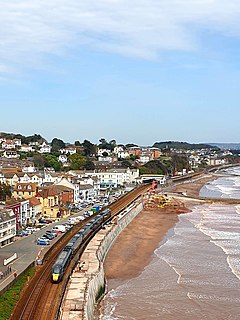
Dawlish is an English seaside resort town and civil parish in Teignbridge on the south coast of Devon, 12 miles (19 km) from the county town of Exeter and from the larger resort of Torquay. Its 2011 population of 11,312 was estimated at 13,355 in 2019. It is to grow further as several housing estates are under construction, mainly in the north and east of the town. It had grown in the 18th century from a small fishing port into a well-known seaside resort, as had its near neighbour, Teignmouth, in the 19th century. Between Easter and October the population can swell by an additional 20,000. largely in self-accommodation, caravan, camping and holiday parks

The Riviera Line is the railway between the city of Exeter, towns Dawlish, Teignmouth, and the "English Riviera" resorts of Torbay in Devon, England. Its tracks are shared with the Exeter to Plymouth Line along the South Devon sea wall. It is part of the Network Rail Route 12.
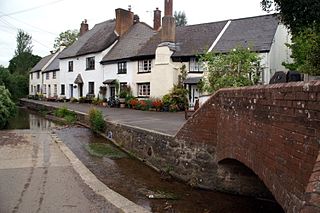
Ide is a village in Devon, England, just under 1 mile southwest of Exeter. The village church is dedicated to the German Saint Ida of Herzfeld and was rebuilt in 1834.

Kingsteignton, is a town and civil parish in South Devon, England. It lies at the head of the Teign Estuary to the west of Teignmouth in the Teignbridge district. It is bypassed by the A380 and is also on the A383, A381, B3193 and B3195. Kingsteignton is currently represented in parliament by Anne Marie Morris, as part of the Newton Abbot Constituency.The local education centers (schools) include : Rydon Primary School, Teign School and Saint Michael's School Church of England School.

Coffinswell is a small village in South Devon, England, just off the A380, the busy Newton Abbot to Torquay road. It lies within Teignbridge District Council.

The Stover Canal is a canal located in Devon, England. It was opened in 1792 and served the ball clay industry until it closed in the early 1940s. Today it is derelict, but the Stover Canal Society is aiming to restore it and reopen it to navigation.

The Haldon Hills, usually known simply as Haldon, is a ridge of high ground in Devon, England. It is situated between the River Exe and the River Teign and runs northwards from Teignmouth, on the coast, for about 24 km (15 mi) until it dwindles away north west of Exeter at the River Yeo, just south of Crediton. The highest points of just over 250 metres (820 ft) lie to the south west of Exeter. The southernmost part is known as Little Haldon; it is partially separated from the main bulk of the hills by a col formed by the valleys of the Dawlish Water to the east and the valley at Rixdale to the west.
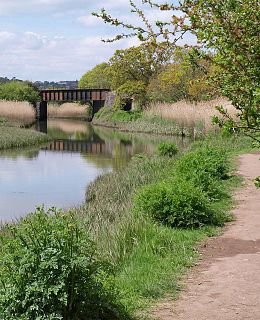
The Hackney Canal was a short canal in Devon, England, that linked the Hackney Clay Cellars to the River Teign. It was privately built by Lord Clifford in 1843, and throughout its life carried ball clay for use in the production of pottery. It closed in 1928, when its function was replaced by road vehicles.

Combeinteignhead or Combe-in-Teignhead is a village in Teignbridge, South Devon, England. It lies within the civil parish of Haccombe with Combe, between Newton Abbot and Shaldon, about half a mile (1 km) inland from the estuary of the River Teign.

Riverside Country Park is a large coastal public park, situated alongside the River Medway estuary between Gillingham and Rainham. The park covers about 100 hectares - approximately 247 acres (1.00 km2). There are a variety of natural habitats within the park, including mudflats and salt marsh, ponds and reed-beds, grassland and scrub, which provide a haven for wildlife.
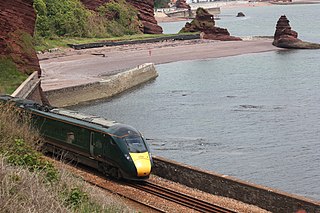
The Exeter–Plymouth line, also called the South Devon Main Line, is a central part of the trunk railway line between London Paddington and Penzance in the southern United Kingdom. It is a major branch of the Great Western Main Line and runs from Exeter St Davids to Plymouth, from where it continues as the Cornish Main Line. It was one of the principal routes of the Great Western Railway which in 1948 became part of the Western Region of British Railways and are now part of the Network Rail system.

Highweek, less commonly called Highweek Village, in South Devon, England, is a parish, former manor and village, now a suburb of, and administered by, the town of Newton Abbot, but still retaining its village identity. It is prominent and recognisable due to its high location on a ridge on the north edge of the town. The area is the centre of the modern electoral ward of Bradley. Its population at the 2011 census was 5,043.
James Templer (1748–1813) of Stover House, Teigngrace, Devon, was a Devon landowner and the builder of the Stover Canal.

Teigngrace is a civil parish centred on a hamlet that lies about two miles north of the town of Newton Abbot in Devon, England. According to the 2001 census, its population was 235, compared to 190 a century earlier. The western boundary of the parish mostly runs along the A382 road; its short northern boundary along the A38; and its eastern partly along the rivers Bovey and Teign. It comes to a point at its southern extremity, near Newton Abbot Racecourse. The parish is surrounded, clockwise from the north, by the parishes of Bovey Tracey, Kingsteignton, Newton Abbot and a small part of Ilsington.
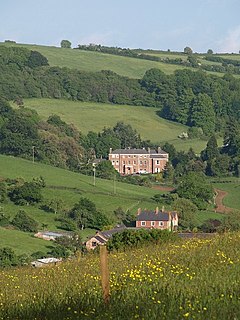
Haccombe with Combe is a civil parish in the Teignbridge local government district of Devon, England. The parish lies immediately to the east of the town of Newton Abbot, and south of the estuary of the River Teign. Across the estuary are the parishes of Kingsteignton and Bishopsteignton. The parish is bordered on the east by Stokeinteignhead and on the south by Coffinswell. Most of the southern boundary of the parish follows the minor ridge road that runs between the suburbs of Milber in Newton Abbot and Barton in Torquay and it bisects the Iron Age hill fort of Milber Down.
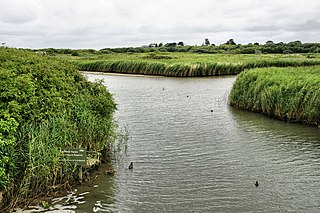
Titchfield Haven is a 134.5-hectare (332-acre) biological Site of Special Scientific Interest north-west of Gosport in Hampshire. Most of it is a local nature reserve and a national nature reserve. It is part of Solent and Southampton Water Ramsar site and Special Protection Area.